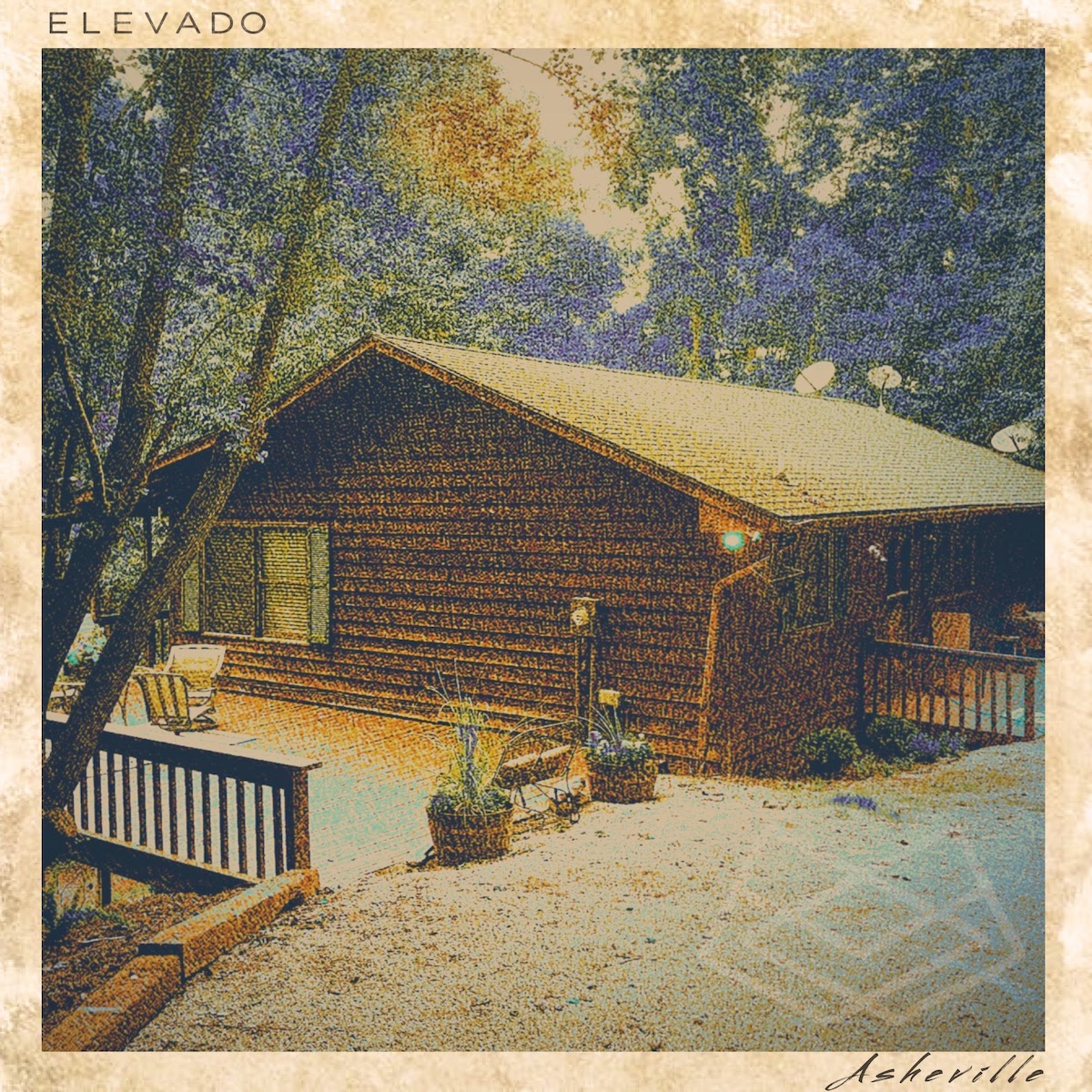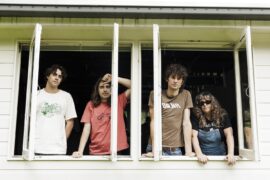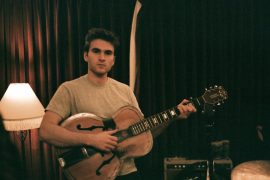Talking with Moonatic about their jazz infused new album ‘Music for Wandering’ led to a deep reflection about the short attention span in today’s music culture.
Stream: ‘Music for Wandering’ – Moonatic
In late 2022, Moonatic did an interview at one of Mexico’s main alternative radio stations.
They were there to present a song titled “with the sky”, from their then upcoming album Music For Wandering (out now via PYL Records). It’s a seven-minute track that starts with two saxophones playing short shrieking notes. A synth joins them with sparse sounds and they all engage in an awkward conversation, sort of answering each other with no discernible rhythm or melody.
The instruments overlap and stutter, but if you pay close attention, each one individually and slowly begins to find a groove. It sounds as if they’re figuring out what to say right there on the spot… and that’s because they mostly are. All of Moonatic’s new album was recorded live with minimum rehearsal in just two takes with the intention of highlighting the improvisational nature that the music emerged from.
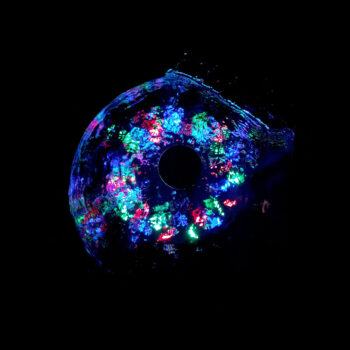
This Mexico City based project, formed in 2013, is known for building songs patiently and crafting evocative atmospheres, never in any rush to “get to the hook”. In this particular case, it takes around two minutes for saxes and synths to arrive at a place of harmony and another forty five seconds before the bass and drums come in to lift the jam off from the ground, sending it on a wonderful journey of edgy jazz with sci-fi vibes and hints of electronica.
A constant unassuming riff provides all the control and clarity needed for the other musicians to explore freely. Then, when you think things might have reached a plateau, a piano appears out of nowhere to split the song and something magical happens: it leads things back to a dynamic with improvised licks and sudden stops. The instruments engage in a new conversation, only this time it’s not awkward at all. It’s light and playful and every note is on the same wavelength.
The whole track could be understood as a metaphor for human communication and music as a language, but there’s one problem. If you happened to be listening to the radio on that particular day Moonatic went on air to present “with the sky”, you wouldn’t have had the chance to experience what I just described. The programmer faded out the song before the five minute mark. “You know how radio is…” the host apologetically said. I guess we do, but if a university funded non-profit alternative station isn’t willing to play a seven minute instrumental, what does that say about the attention span of today’s musical culture as a whole? To me, the most troubling thought isn’t that a radio station wouldn’t play a long experimental song, but that they would invite the band with the explicit purpose of showcasing their new work and then not be willing to play the full thing.
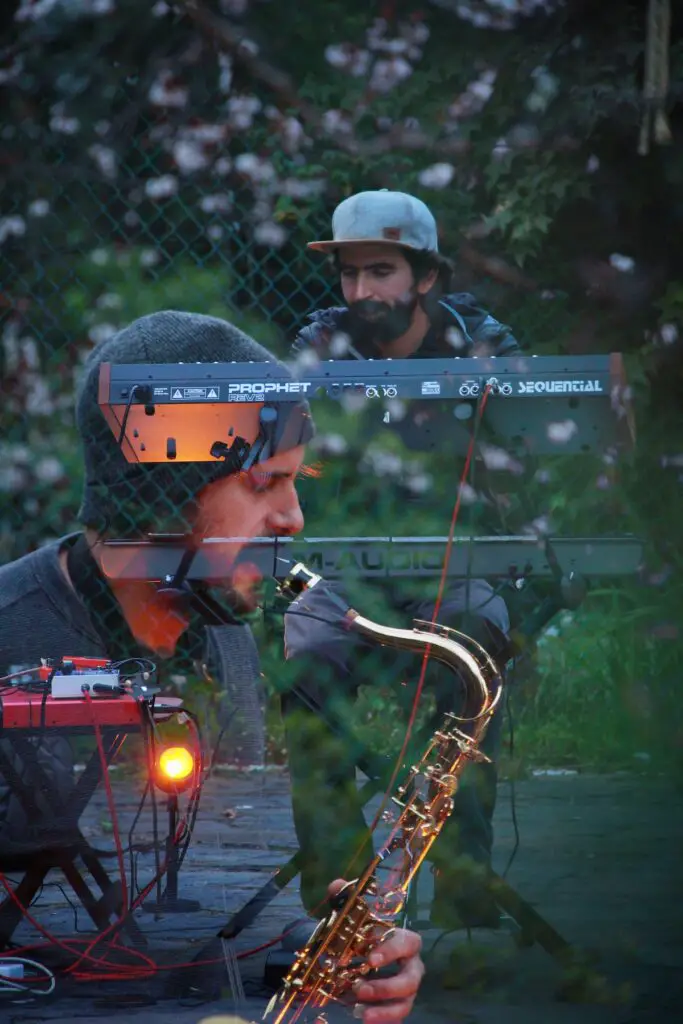
The behavior is flat out schizophrenic, sending out two opposing messages: Yes, we are a space that welcomes and champions weird genre-defying projects. But sorry, we are afraid your music will bore our audience if we leave it on for too long. This might be an isolated anecdote, but it serves as a reflection of an identity crisis I believe many, from media outlets to emerging artists, in the independent music sphere are having. Not knowing exactly where to stand between the abstract value of remaining true to their philosophy and the measurable reward of staying above water in the numbers game of likes, views and plays.
That’s why albums like Music For Wandering feel so urgent. In the shifting ice of an industry that increasingly prioritizes social engagement over any other form of connection, creating music that isn’t afraid to lose our attention is one of the bravest things an artist can do. I exchanged a series of voice notes with Moonatic’s keyboardist, Jorge de Haro, to discuss the ideas and processes behind the band’s latest release: a five song gem that echoes a wide range of instrumental influences –from post-rock to modern jazz to certain film scores– and molds them into a style that feels fresh and genuine. De Haro is also one of the band’s former singers. That’s because their debut EP Inner and their previous full length Another Sky were vocally oriented efforts with complex lyrics and lush atmospheric harmonies.
Back then, Moonatic’s music, while psychedelic and experimental, was still very much in the realm of indie-rock. I asked Jorge about the reasons behind their move towards longer instrumental compositions.
“Being scattered and disorganized is our natural state. We all have other artistic and professional projects, aside from the band. So whenever we get together after a while, we aren’t looking to sound a certain way or to continue where we left things off. We are just trying to play stuff and write music that excites us at that moment. Our main goal is to have fun, to stay curious and not get bored.”
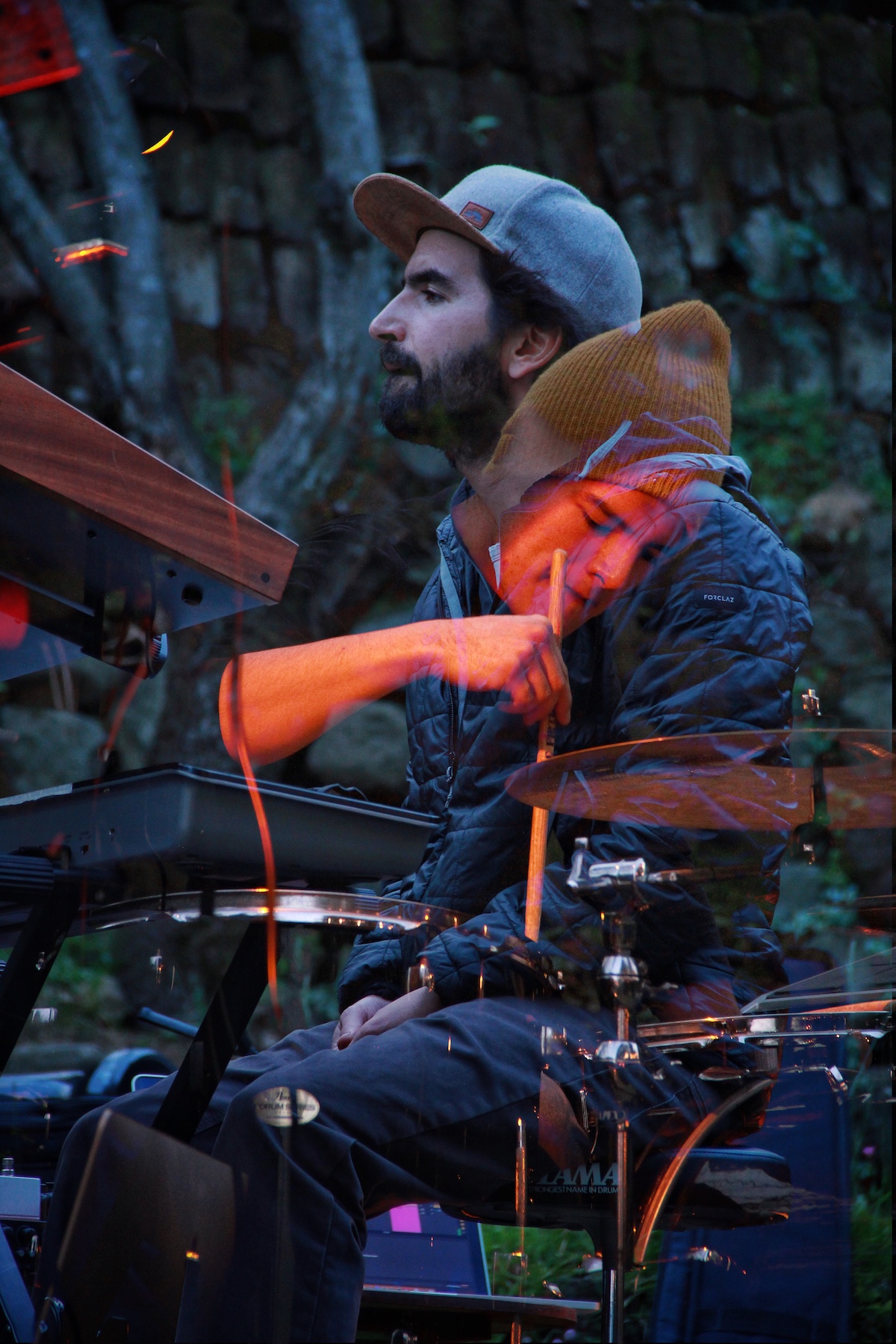
During the lockdown months of the pandemic, de Haro was living near the woods in the outskirts of Mexico City just down the road from Fernando Esteban, the band’s other founding and longest serving member. It was there that evenings improvising on synths, drums and piano (none of those their usual instruments) became the seeds for Music For Wandering, not as a conscious decision, but as a natural process of ideas evolving into songs.
“We could stay ten minutes playing the same five or two notes, taking all the time in the world to explore just that idea. Afterwards, when we were having a drink or a smoke listening to the jam recordings, it became obvious that we wanted the songs to feel just like that, without any hurry. I think when you try to get right to the point, you miss all these beautiful moments of contemplation.”
Moonatic’s approach draws from the jazz school of thought that sees recordings as just one possible take of a song, rather than a definitive version. Songs, in this view, are living entities that evolve over time, with each performance adding something new to the mix. In Music For Wandering, they took this philosophy to the next level by inviting collaborators from other fields to intervene in their work, establishing a multidisciplinary dialogue that pushes the boundaries of what releasing a record means nowadays. The full project contains poetry, essay, photography, animation and dance, leading to a conceptual album that is not only rich in musicality, but also in visual and literary elements that add depth and complexity to the listening experience.
Some of the collaborations are incorporated into the tracks, while others are companion pieces inspired by a specific song. But the most remarkable and interesting case comes with “in the world”. Here, the music serves as the soundtrack to an entirely original work of animation. Visual artist Juan Manuel Pavón spent over a decade photographing what he calls “the non-visible spectrum” of Mexico City. Through stunning editing, Pavón makes over 1,500 still abstract images come to life with movement and narrative, synchronized to the song. At first glance, they can appear to be generic trippy visuals, but once you pay attention and understand what you are looking at, it becomes clear that it could well belong in a museum or an experimental film festival. By itself, “in the world” is a brilliant slow burning mix of glitchy sounds, minimalist pads and wild chaos. Paired with Pavon’s photographs it’s a vortex to another dimension.
The only words in the album come in the form of a spoken monologue in the opening track, “the unspeakable world”. On top of soft beats and ethereal melodies, a female A.I. voice gives a thought-provoking speech on the nature of language and how it shapes our relationship with the world around us. These lyrics were adapted from an essay written by Moonatic’s saxophone player, Enrique Bojorquez. One particularly beautiful metaphor compares the world of concepts to a prison that looks like a palace. “It is so beautiful that you can forget about the universe that holds it” says the A.I. character in a tone that slowly becomes more human-like with hesitations and emotion, until it invites us to “wander through the unspeakable world” that lies beyond.
This theme is central to the album, as the band experiments with instrumental and fluid compositions that aim to convey emotions and sensations directly, letting the sounds and textures speak for themselves. The experience is much more visceral than intellectual. De Haro explains:
“The structure of these songs is flexible, almost amorphous. We know we have to get somewhere: get to another hook or to a soft quiet part, but we don’t know how or when we’ll get there, it just kind of happens. It’s something driven by feeling. The more the band improvises together, the better we are at communicating and understanding each other through subtle musical cues.”
While individually, the members of Moonatic may not have the technical proficiency of some of their influences, such as Nils Frahm or Snarky Puppy, as a band they possess a rare chemistry that allows them to dive fearlessly into the same realm of pure sound and freedom. They explore dissonances and harmonies in a way that feels unpredictable and uniquely theirs. What’s most interesting is that in 2019 I could have written the exact same idea, but with Grizzly Bear and Radiohead as the examples. More than any style, it’s the openness to change and a compulsion to stay curious that best encapsulates Moonatic. If they keep it up, it could make for quite an eclectic discography in the future.
“We have no idea what the next album could sound like, it might be made of sequencers, pianos, ukuleles and have lyrics again… Or folky acoustic stuff… It will be whatever seems fun to us at the moment. And also a lot of it comes down to the instruments that we have laying around. If one of us buys – let’s say a new weird analog synth– then it’s very likely, after playing around with it, it will start becoming part of the sound.”
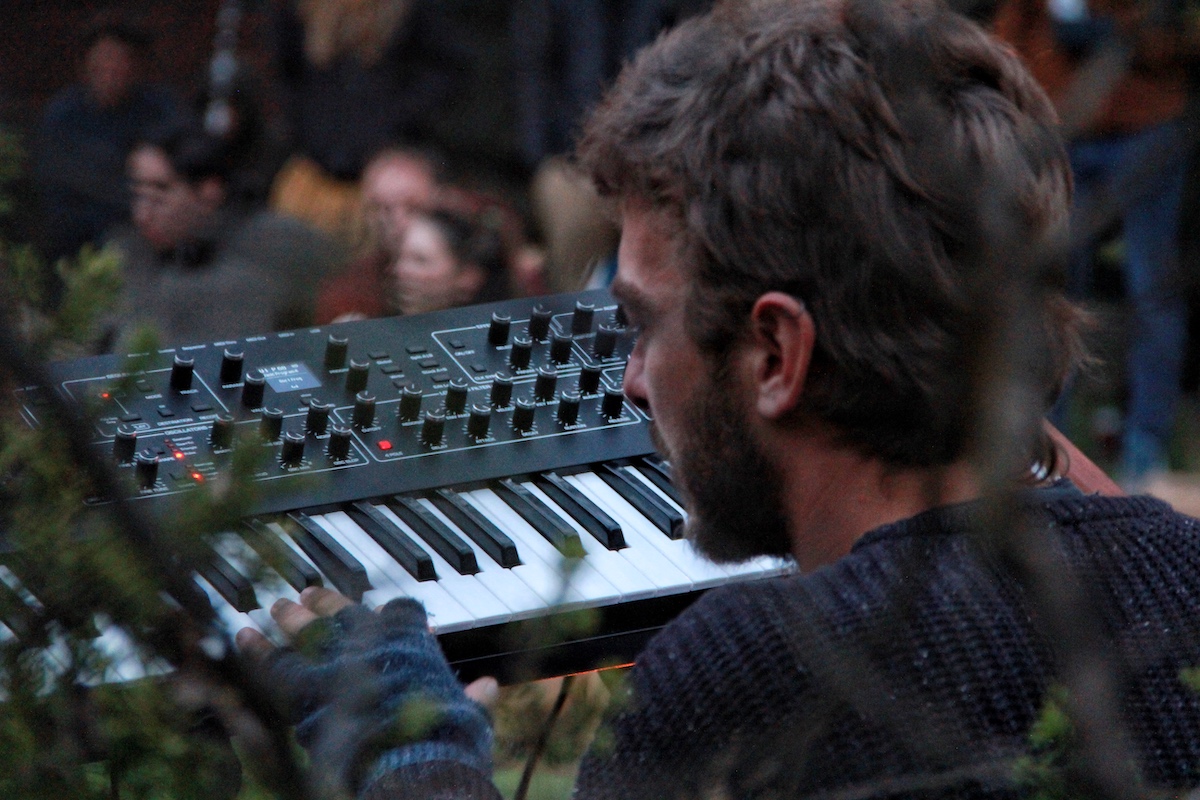
Looking back at the progress of Moonatic’s career, one could think that they are actively self-sabotaging themselves.
Around 2014 they were rising fast in the Mexico City indie scene, playing important venues and sharing the stage with relevant international acts like The Album Leaf or Low Roar. At one of their first gigs, I remember Santiago Mijares (of Little Jesus and Big Big Love) telling me: “they’re gonna be the best band in town”. There was a clear path for them there, but they never stopped making their sound more elaborate and less accessible, always pushing the music one step ahead of their ability. Instead of releasing singles as the norm demands nowadays, they put out their 2019 album Another Sky as one single track. And now, they risk alienating the small cult following their past effort gained them.
However, in my exchange with Jorge de Haro I realized that they’re not fighting against the industry because they know that’s a lost war. Just a few years back, there was still a sense of hope that the democratization of music would open the door for non commercial projects to find a real audience and develop a healthy middle class of artists. That promise never paid off for a number of reasons, but the main one perhaps is that attention became the new gatekeeper. No matter how diverse the offer is, it’s still getting channeled through a narrow pipe because if you aren’t already an established act, then it’s almost impossible to break through without having a product that’s optimized for streaming platforms and social media trends. And on top of that you have to throw that even college stations won’t play a seven minute track.
So Moonatic’s response isn’t one of defiance, but of genuine indifference to the whole thing. Music For Wandering is the wordless manifesto of a band that creates without compromise, allowing music to take as much time as it needs to unfold and building an ecosystem that requires sustained presence. There are no obvious chill-inducing moments, nor proven formulas. No fireworks or pretty sunsets. Listening to this album is more like staring intently to the way the leaves and branches of a tree move tirelessly with the wind. You can watch from afar and see them sway gently or you can come up close and discover a tiny universe of patterns. When I ask Jorge for a comment on all this, he puts it more plainly: “Fuck it. We are doing this for ourselves”.
— —
:: stream/purchase Moonatic here ::
— — — —

Connect to Moonatic on
Facebook, Instagram
Discover new music on Atwood Magazine
© Cons Kaye
:: Stream Moonatic ::

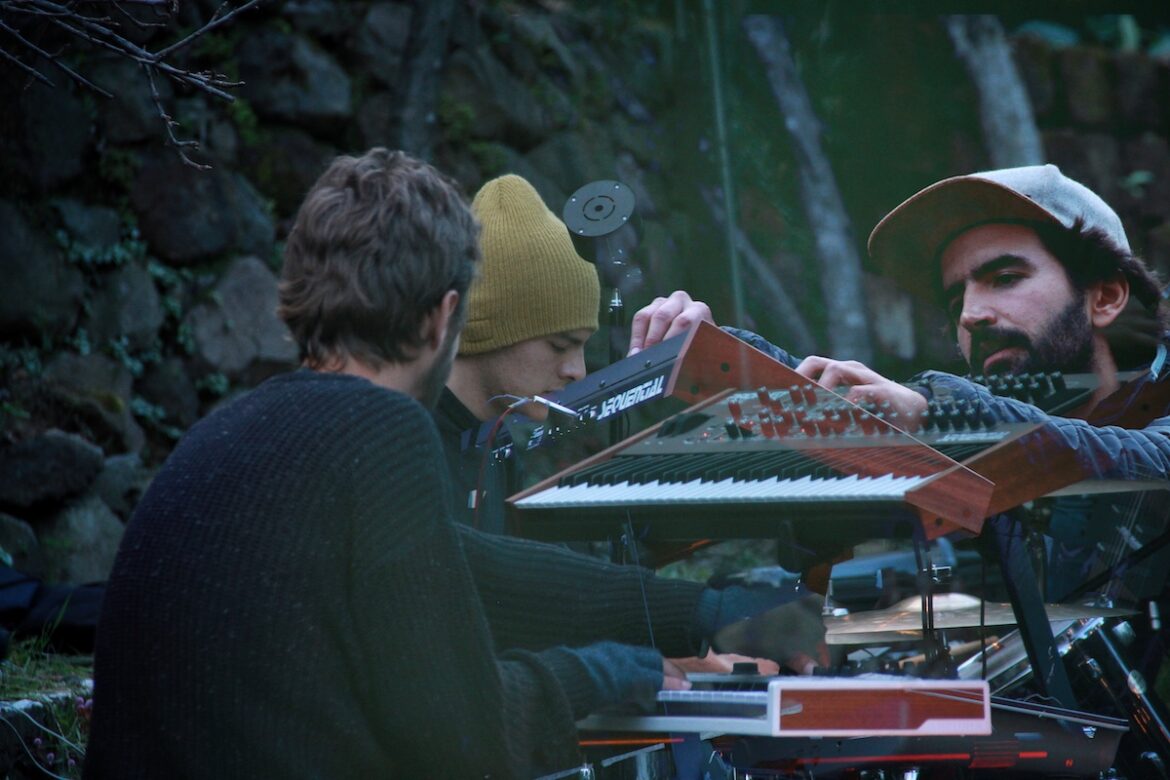
 © Cons Kaye
© Cons Kaye